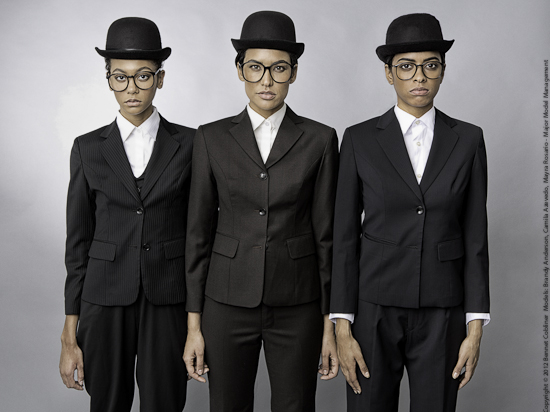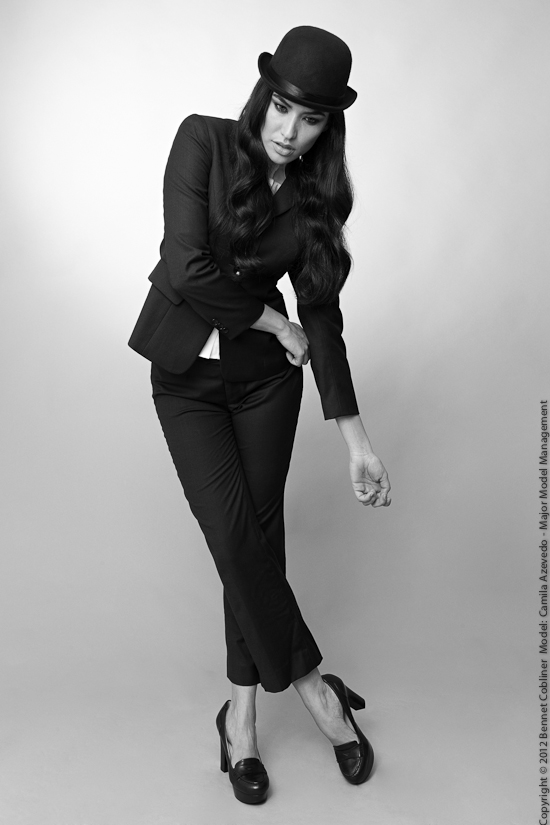As a photography enthusiast, I am always fascinated by the diversity of talent and perspectives that one encounters, but more importantly, I am amazed by the level of creativity that is to be found in up-and-coming photographers, those with a unique vision of the world and the fearlessness to portray it without compromise. One such artist is Bennet Cobliner, a New York-based photographer who is equally at home doing commercial photography and glamour shots as he is doing artistic portraits, and whose mild-mannered charm puts subjects at ease even as he firmly guides them to a clear vision of the image he intends to convey.
I talked to Bennet about one of his recent shoots, inspired by the painter Magritte. Surface similarity to the famous painter's works is clear, although Bennet's photographs also add his own unique interpretation and style to the images, influenced by the trend of androgyny in fashion photography and the changing perception of women in society. When I compared the final images to the paintings by Magritte, I was startled by the similarity and stark differences between the results of the two art forms.

I decided to pick Bennet's brain about the evolution of the "medium" used to convey images and how that and other factors have impacted the image-maker's techniques as well as the pictures themselves. These were my takeaways from that discussion.Life and Art Imitating Each OtherBeyond the obvious evolution of fashion, today's depiction of men and women has been impacted by many other factors. As women's accepted roles in society and business evolve, their past depiction as homemakers, maternal figures, and sexual objects has gradually given way to more powerful images of leaders, trailblazers, and sexually liberated beings, while the perception (and depiction) of men has changed from solely a breadwinner to stay-at-home dads and other modern roles. Accordingly, the amount of androgyny currently found in photographic imagery could be interpreted as a sign of modern society's efforts to resolve this tension between the sexes.
Another factor is the liberal time in history that we live in, which gives modern photographers the opportunity to explore the similarities and differences between the sexes through role-play and role-reversal, appearance, and attitude in ways that were not accepted before. The choice of subject matter and style are also, of course, driven by pop culture, fashion and movies.
The photographic process is not free of the personal either. Just as the style of a painting might say as much about the artist's personal sensibilities as the subject itself, a picture conveys the photographer's view of the world as surely as the actual world itself. A portrait, for instance, may say as much about the photographer as it does about the subject; the image is representative of the influence of society and the psychology of the image creator.
This, in turn, impacts what we see. Even as society influences photography, photography influences society in return. The images that we view can have a profound impact on our psyche and alter our way of looking at things by giving us serious food for thought, even if the photograph itself has been digitally edited. That is a tremendous amount of power for a photographer to wield and Bennet views it as both a privilege and a responsibility. In fact, serious photographers do not consider what they see through a camera lens as a static image, but a dynamic, powerful force that has the potential to shape the thinking of the viewer. Photography vs PaintingBoth photographers and painters need to understand composition, but the techniques used to create images are quite different. There are many complexities that impact painting, such as the varying qualities of paint, the many types of brushes, and even the type of canvas used. Photography's paint, on the other hand, is primarily light, and so the real skill here is the ability to reconcile and shape what the camera "sees" with the image that the photographer has in his mind. That, combined with the requisite knowledge of digital cameras, printers, and Photoshop, are the tools of today's artist.
But there is also the human factor. In painting, the interplay between the artist, the subject, and the surroundings need not have as much impact on what is ultimately created by the artist's brush; but in photography, the presence of the camera and the fact that it records rather than creates an image can affect the results substantially (notwithstanding post-click editing). That is why good portrait photographers do not just take pictures, but need to be able to get an authentic result while being mindful of composition and the effects of lens, camera and lighting choices as well.
The Impact of Technological Advancement on PhotographyDigital cameras that can record useable images in near darkness and at lightning-fast speeds have opened up a wealth of possibilities for photographers; images can be taken in near darkness without the intrusion of a flash, and unpredictable "moments" can be captured at weddings and events that were previously impossible. Software that can correct or alter the image after the fact, such as Photoshop, is also changing the industry and the art form. The ideal woman or man is now achievable through just a few mouse clicks to remove blemishes, lines, disorderly hairs, alter curves along the waist and back, etc.
Bennet was quick to point out, however, that all this technology can also be a curse, making it harder to determine "reality" and reducing the need for aspiring photographers to develop solid technique, as in years past. The perfection attainable via technology, particularly in the world of fashion, has skewed our expectations, requiring models and women everywhere to live up to an unrealistic ideal that does not and probably should not exist in real life. Of course, magazines such as Vogue and Seventeen have pledged to provide healthier role models for women, while companies like Sephora have announced ad campaigns with an un-retouched image. So, perhaps, society can adapt to new trends without becoming victim to them. Only time will tell.
One thing that has not changed much since the time of Magritte is the use of lighting to define an image, but what is changing is the technology that photographers use to control, shape, and direct that lighting. Lighting equipment that uses high efficiency flashes and LEDs rather than hot bulbs enables the creation of artificial daylight at will, while reducing power consumption and heat typical of past solutions. In addition, a lot of lighting modification can now be done in post-production with computer software.
Still, despite the flexibility, speed and cost advantage of modern technology, many photographers feel that there is something missing in digital, similar to what music enthusiasts complain about when comparing classic LPs to digital files. Digital photography relies on a programmer's coding or a hardware engineer's design to determine how light will be captured and color represented in the photograph, which creates a predictability that was blissfully lacking in the chemically uncertain medium of film. Some might even call this x-factor the "soul" of photography. Time will tell if advances in technology will allow that unpredictability factor to be recreated and whether future generations (who wouldn't know the difference) would even care. StyleFinally, if there is one thing that is the same today as it was in Michelangelo's time, it is the importance of style to an artists' work. Just as painters developed distinctive signature styles, photographers, particularly in fashion, use it to make their images easily recognizable and so that their particular style can be used to support a client's intended brand image. While Bennet does not feel that true style is something that can be consciously created, he does agree that there are certain artistic flourishes that all great photographers, past and present, like Irving Penn, Richard Avedon, and Helmut Newton to Patrick Demarchelier, Nick Knight, Tim Walker and Greg Kadel perfect over time - a bit like looking in the mirror and practicing the way you smile.

After visiting with Bennet and looking at his portfolio of work, including editorials, beauty, portraits, events and still lifes, I felt I had gained a new understanding of the medium. Bennet is clearly an artist who values his craft; he says that he looks forward to working with creative fashion designers and major magazines to create imagery that is not only commercially successful but also artistic and meaningful. The images included here are part of Bennet's Magritte-inspired editorial. If you would like to see more of his work, you can find it at www.bennetcobliner.com